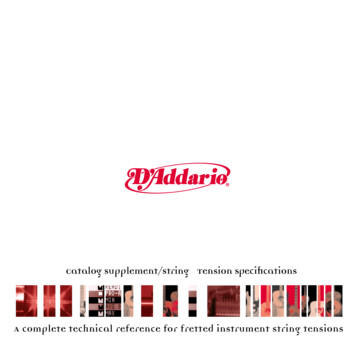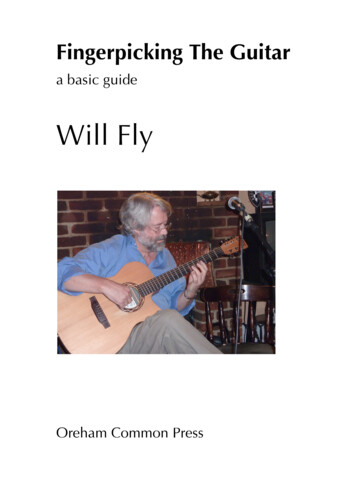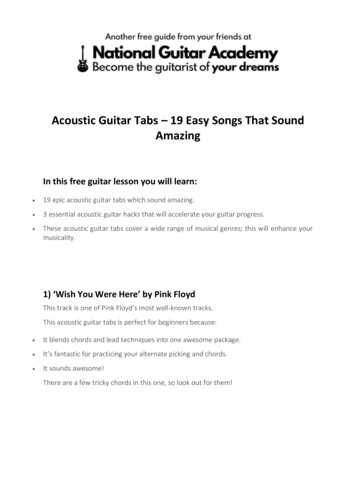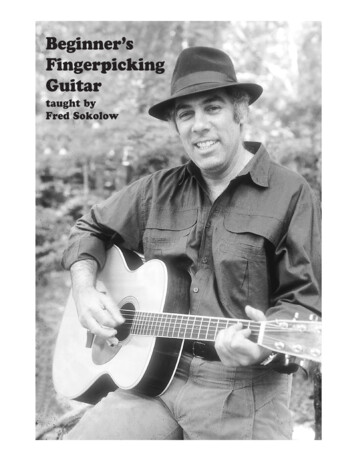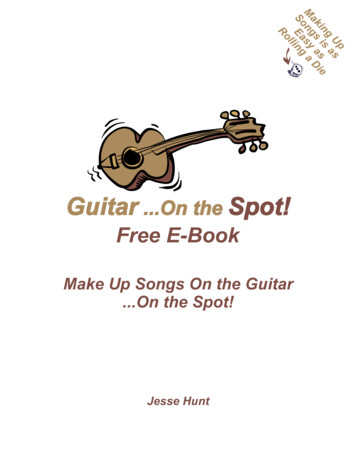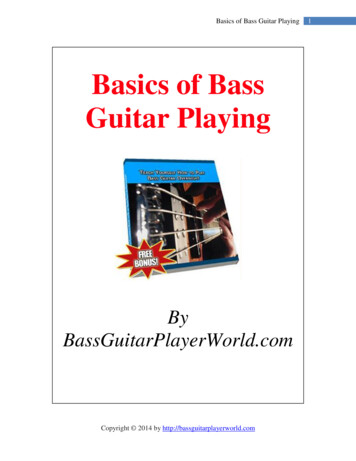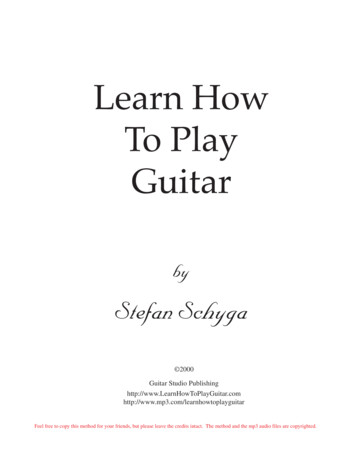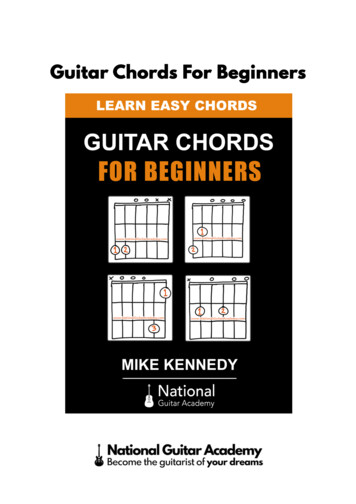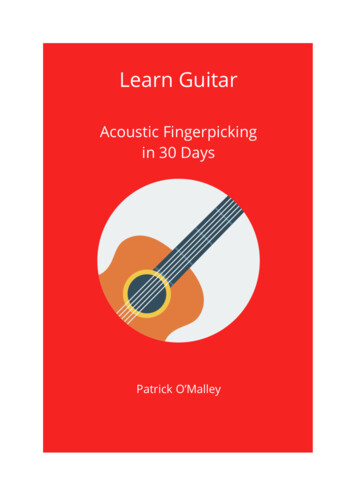
Transcription
CHAPTER ONEGetting Started
IntroductionThank you for reading this Acoustic Guitar Fingerpicking ebook. I’m soexcited that you want to take this course and I promise you I’m going to doeverything in my power to make sure you’ve got all the tools you need to be afantastic acoustic fingerpicker.What You Will LearnFirst thing I want to do is welcome you to the course. Well done for makingthis commitment. I take it as a privilege that you have chosen me to be yourguitar teacher. I have prepared absolutely everything you need to learn thefundamentals of fingerpicking and to play your first song - descriptions, photos,chord charts, guitar tablature etc. Here are some of the things you will learn inthis eBook: Three chords String names How to practice How to play with a metronome (good rhythm from the start!) How to play guitar tab (pick up a guitar book and play!) What fingerpicking patters will work over G, C and D chords Which right hand fingers to use for each picking pattern Five different picking patterns How to find bass notes in each chord How to isolate and practice your right hand finger technique How to isolate and practice your right hand thumb techniqueWho This Course is ForFinally, I want to say that you are perfect for this course if you are a beginneror a failed beginner. A ‘failed beginner’ is someone who tried to learn before,maybe even played a few chords but gave up after a while, maybe becauselearning wasn’t engaging enough or playing guitar didn’t stick. If that’s you or ifyou are a complete beginner, then this course is perfect for you. You can callyourself a fingerpicker if you can play the song at the end of this PDF, so goodluck!
Who Am I?My name is Patrick O’Malley. I have been giving guitar lessons for over 15years and about ten years ago, I started teaching all my new students tofingerpick from lesson one. I noticed that the students who started this wayalmost always stuck with the instrument and kept returning for more lessons. Ialso noticed that they were far more musical and creative from an early stage, incomparison to students who began with chords, scales and theory. I still meetand play with many of them to this very day.Believe it or not, I was very good at maths when I was younger and to manyextra money I would give maths lessons to kids (teenagers) when I was incollege. I always noticed one thing about maths - wherever anyone was stuck,they were always missing a key building block that was necessary. In my guitarteaching, I have over the years observed what common building blocks studentsare missing to understand what is required to play guitar and indeedfingerpicking, so I’m confident that the way everything is presented here is goingto give you what you need to get to the end of the book and hopefully continuelearning far beyond that.I have a guitar site dedicated to learning fingerpicking at the suitably titledhttp://www.learnfingerpicking.comI wish you success and hope you soon enjoy playing guitar as much as I do.Patrick O’Malley
Some ResourcesThere are a few things that you need before you get started:1) Have a guitar2) Be able to string up your guitar3) Be able to tune your guitar4) Be able to read some guitar notation (or tablature).The chances are that you already have a guitar if you are reading this eBook. Butif not, then check out some ofthe options here https://www.youtube.com/watch?v h03QB iDPqEIf you have an old guitar and you need to buy strings, then it’s probably good toget a light set of strings or “11gauge strings” for your acoustic. You need to be able to put strings on your guitarso if you can’t do it yet, then bitthe bullet and try. Worst case, you muck it up one time so maybe buy two sets ofstrings in case. But you can’t getout of being able to change your own strings so dive in there if you have to. Thisis a great YouTube video if youneed guidance on how to put strings on your guitarhttps://www.youtube.com/watch?v vcYS117qyco&list RDvcYS117qycoFor tuning your guitar, there is a good guide here if you have never done it https://www.youtube.com/watch?v TDw2yWW1ThYFor reading tablature, we deal with that in a later section so don’t worry. Youhave all the basics you need.
String NamesLet’s start with some basics. The names of the six strings. Look down at theguitar. The string nearest your head, which you will notice is the thickest stringalso has the most bass sound. It is an E note. We call this the 6th string for therest of the book.The next string (the next thickest and next nearest your head) is the A stringwhich we call the 5th string. Then we have the D string (which we call the 4thstring), G string (3rd string), B string (2nd string) and then the thinnest string(furthest from your head) is another E note which we call the 1st string.You will notice two strings are E notes (6th string and 1st string) but if you playthem both you will hear that one is quite bass-sounding (the low E) and one isvery high pitched (the high E). It’s worth saying that when we say low here, wemean the tonality of the note (and not where the string physically is on theguitar).There are ways to remember the string names. If you can remember thephrase “Eat Apples Daily Grow Big Ears” then that mnemonic will help youremember EADGBE, the strings in order.“Three ChordsThe first 3 chords we learn are G, C and D.Have a look at the chord charts below and we’ll learn these three chords in
no time! When you look at a chord chart, the number in the black circle is thefinger (left hand finger) to use. The low E or thickest string is on the left and thehigh E or thinnest string is on the right. .So for the G chord, put the second finger of the left hand on the low E orthickest string at the third fret. Then put the index finger of the left hand on the Astring (string below) at the second fret. Then put the third finger of the left handon the high E or thinnest string at the third fret. Then play all six strings and youget a G chord. Make sure to take your time and play each note individually tomake sure they all sound nice and clean.For the C chord, put the third finger of the left hand on the A string (5th string)at the third fret, then the second finger of the left hand on the D string (4th string)at the second fret and the index finger or first finger of the left hand on the Bstring (2nd string). This time, you only strum five strings with the right hand - thelow E or thickest string you don’t need to play.For the D chord, you put the index finger on the G string (3rd), the third fingeron the B string (2nd) and the second finger on the high E string (1st). Now youstrum four strings with the right hand (not the two lowest the E and A strings).Take your time, play each chord slowly and make sure you do two thingswith the right hand, strum the whole chord then pick each note individually.When playing individual notes, listen for any bad or wrong notes and thencorrect (by taking a good look at what the left hand is actually fretting!). Playingindividual notes of the chord is the way to know if you make a mistake.
Reading TabGuitar Tablature (or guitar tab) is a way of notating music for guitar. It is notquite reading “sheet music” like our piano playing friends, it is a little bit easierbut still takes a little getting used to.We’ll start by playing a melody on one string. Then we will add other strings.Then we will look at how chords are written in tab.So we’ll start by looking at playing one note - the 6th string (low E). This isjust playing an open string so don’t fret anything with your left hand - just playthe thickest string on your guitar and let it ring. Note if you are not fretting astring, then we call that an open string and it is denoted in tab as a ‘0’.Now if we play that same string (the low E string) three times: first as an openstring, then at the 3rd and 5th fret, it would have guitar tab that looks like thisNow if we play the same string low E four times - first open, then 3rd fret,then 6th fret then 5th fret, it would look like this.Finally if we play both patterns above then follow by play the low E stringopen, 3rd fret, 5th fret, 3rd fret, open string, you are playing Smoke on the Waterby Deep Purple. You do know this riff! Google it if you are not familiar with itand then hum it and then play this tab until it matches. Now you will havefollowed tab to play a song on one string and from here adding other strings isrelatively easy.
Notes on Several StringsSo now let’s play the 1st string (high E / thinnest string) three times open.Repeat.And now play the high E string open, then at the third fret.And now the 2nd string (B string) at the first fret then third fret.And finish by playing the 1st string (high E) open.Congratulations. You have just played Jingle Bells - but really this is kindacool because this is reading tab on two strings!Playing Notes at the Same TimeUp until now, we have played notes sequentially, meaning one then the nextone after that.But what if we want to play two notes at the same time?Well if we play the 6th string (low E) open and the 5th string (A) at the secondfret - at the same time - then it looks like thisAnd if we wanted to show a G chord using tab, it would look like this.Remember from the last section how to play a G chord. We fret the 6 string(or low E or thickest string) at the third fret. Then we play the 5th string (A string)at the second fret. The 4th and 3rd strings (D and A) are open. Then we play the6th string (the high E or thinnest string) at the third fret.
CHAPTER TWOFingerpicking
Starting To Fingerpick - The Big RuleIn order to play fingerpicking guitar, the real key to begin with is the righthand. So for the first few lessons, we will play something easy with the left handlike a G chord or a D chord - that’s it! So start by fretting a G chord with yourleft hand. That’s all we’re going to do for the rest of the lesson with the left hand.The Big RuleWhen you play guitar, you use two hands obviously and the right hand fretschords or individual notes and the left hand hits the strings. When you play achord, you hit all the strings at once. But when you want to do fingerpicking,then each finger will hit individual strings.In playing guitar with the fingers, there is one big rule: The thumb plays the bottom three strings (the bass strings which are the6th, the 5th and the 4th) and it has ownership for any notes played onthose three strings (the one nearest your head) and the other three fingersplay one string each! If there is a note on the 6th, 5th or 4th string, the thumb must play it. The index finger always plays the G string or third string. The middle finger always plays the B string or second string. The ring finger always plays the high E string or first string.And that’s it!
It sounds simple. It is simple! But at first, it will take a little bit of practice forthose fingers to obey you. In particular, in a rush to play what the brain is tellingit, some students end up playing it with one finger - because it is easier. Well, ifyou notice that, just make yourself practice using the right fingers per stringagain. And here’s a great exercise if you notice that happening.One Finger Per String Exercise - Open StringsWhat we will do now is play a G chord.The bass note is on the sixth string (low E string). Let’s play that four timeswith the thumb (T)The G string is played by the index finger - let’s play that four timesThe B string is played by the middle finger - let’s play that four times.The high E string is played by the ring finger - let’s play that four times.
Exercise 1It’s actually really nice to play each of these notes four times. Because whenyou do so, it gives your mind some time to play and also to think about ‘am Iusing the right finger there?’.So as a beginner, feel free to play this exercise a few times. If you think it’sreally super easy, then try to speed it up. But the most important thing is usingthe right finger, not speed.One Finger Per String Exercise - G chordExercise 2Here we play the 6th string (the low E string, the thickest one!) at the thirdfret, then the open 3rd string (G) and the open 2nd string (B) and finally the open1st string (the high E).Here we are not focused on speed; instead we focus on using the rightfingers of the left hand and having a nice clean note! That’s the most importantthing.Assignment 1So your assignment after our first lesson is to play this pattern (exercise 2) fora few minutes until you are comfortable with it. Feel free to stick with just the Gchord. But try something new also with the right hand. Experiment! Dosomething different! Maybe it is to play the notes backwards (from highest E tothe low E). Or maybe you play each note twice? Maybe you skip a note? I
cannot emphasise enough how great it is for you musically to just experimentand mess around with everything I show you.As a bonus, if you know some other chords, try this pattern - you mightnotice it sounds great with other chords and sometimes not. Any idea why thatis? We’ll explain it in lesson 2, but it’s worth thinking about now.
Fingerpicking with Two ChordsLast AssignmentSo how did playing your first pattern go? Did you experiment a bit and trysome new permutations? If you did, was that fun? Here’s a question - when youstarted playing with other variations, did you keep using the designated righthand fingers per string? If so, awesome.Sometimes we may notice as beginners that you start off playing each stringwith the right fingers but then if we relax our concentration, we find that onefinger may take over. So for example, maybe the index finger tries to play all thestrings!This might be the easiest way to play something today but the problem is thatif we want to play something complex or start to speed up, it’s going to beimpossible. So it’s important that during the first week, we pay particularattention to using the Big Rule of which finger play which strings. Even at areally slow speed (like super slow!) if you are using the correct right hand fingersand thumb to hit the appropriate string, then I am happy.If it was a bit difficult to keep the right finger hitting each string, go back andplay exercise 1 again. That will iron that out for you, guaranteed! Play exercise 1for a while and then go back to exercise 2 and see that the right fingers are beingused!Using a MetronomeThe next thing we will do to help us practice is use a metronome. Ametronome is just a tool that plays a solid beat, and our goal is to play alongwith one. I suggest that you buy one. This Snark metronome is nice and does thejob but any metronome will do. If you don’t have one, it’s ok as you can playalong with me when I’m using the metronome and that will be enough for now.But I’d recommend buying one anyway - it will be huge for your progress.I use a Snark Metronome because it costs around 20 and has differentvolumes which is great if you want to be able to practice sometimes a bit moreloud and sometimes more softly if there are other people you don’t want to
disturb. There’s also free online metronomes that you can use. They will workfine today if you don’t have a physical metronome, but it means you need toturn it on and off at your computer or laptop and I prefer to be able to press aphysical button.Here is a link to a good free online metronome - https://www.metronomeonline.com/legacyPlaying Exercise 2 with a MetronomeLet’s start at 40 b.p.m.So try it yourself, play one note for each hit on the metronome. I’ll let it playfor a little while so that you can try that. So how did that feel? If it was too hardyou can slow the metronome down even more. Or if it was too easy then youcan speed it up!But for now, you just want to use the right fingers of the right hand and makea good connection. Speed will come in time, believe me!Please don’t skip this exercise. Playing something very slowly in time to ametronome and then upping the speed to a higher tempo and then to a highertempo again is a really fundamental part of being able to play accurately intime. At the very least, play along at 60 bpm. It should sound pretty nice andwe’re using the right fingers of the right hand and it’s a great start to building ourfingerpicking technique, which will get pretty complex - but it all starts here.Another PatternSo now we are going to play a very similar pattern. Except now we’re playingthe C chord with our left hand. The one thing to note here is that the thumb hitsa bass note on the fifth string.
Exercise 3Start slowly and make sure the right fingers are hitting the right strings.Assignment 2Your exercise is to play the G pattern above followed by the C pattern, If youknow the chords well already, then your job is to think about the fingers of theright hand - are they sticking to the right strings? Is the thumb hitting the 6thstring for the G bass note and the 5th string for the C bass note?Exercise 4If you are completely new to guitar, then don’t worry about this beingdifficult. It’s great practice and I’m going to give you a great tip for how tochange chords quickly in the next section. But don’t go there yet! Spend 10-15minutes trying to change chords and using the right fingers of the picking hand(left hand).If you have done your 15 mins homework and you want to mess around, trynew things, experiment and see what sounds musical, feel free!
Doing More - With Just Two Chords!Last AssignmentI’m so excited to see you do that last exercise: We have two chords We are changing between them We are fingerpicking each chord We are using the thumb to play different bass notes on each chordNow let’s just consider for a second if you found that hard, your fingerswouldn’t behave themselves and it was just tough to play it the way you wanted.Don’t get frustrated! It’s going to take some time. You can’t just pick up the guitarand do everything, but I’ve three helpful tips and routines so that nobody getsleft behind.Assignment Help 1 - Big Rule ExerciseFirst question, did you stick to the Big Rule? If one finger started to play eachstring (instead of one per string) we play exercise 1. This will help here.Assignment Help 2 - Thumb String Changing ExerciseSecond question, how was it to play different bass notes with the thumb? Wehad one bass note on the 6th string and one bass note on the 5th string. It doestake some practice and concentration. If it was really hard to master, here is anexercise that I would suggest the following exercise. Play your G chord with theleft hand and then just hit the 6th string four times (with the right hand thumb).Then play your C chord and just hit the 5th string four times (with the right handthumb). And repeat. Eventually the thumb should get used to the distancebetween the strings and like any practice - eventually it becomes second nature.You could be having a conversation with somebody and doing this! But in theearly days, it takes some attention and conscious practice.Exercise 5Assignment Help 3 - Easier Chord Changing OptionsThird question, what if the changing of chords was too hard? Maybe once thechord was fretted, you were doing great. You could fingerpick away, and youcould use the Big Rule and it was all fine. But when it came time to get to the C
chord, it took a long time to get those fingers in place. Here’s a little exercise incase the chord changing was hard.If we look at an Em chord chart, it looks like this.Now if we choose to play the 6th string then 3rd, 2nd, 1st strings of the Emchord, we might notice that all of those strings are string that the left hand doesnot fret (they are called open strings for this chord).What that means is that if you take your whole left hand away from the guitarand play the 6th, 3rd, 2nd, 1st strings (the left hand is not used at all) it sound thesame as when you play the Em chord.So that gives us a really easy exercise. Play the G chord and do our lastexercise and then take the left hand off the guitar (slightly off the fretboard) andplay and then put the G chord back on with the left hand).Exercise 6Up & Down Exercise in GOur exercises so far have been in one direction - ascending.What I mean by that is that we started at the thumb and then each note washigher in pitch. Play them again and hum along and you’ll see what I mean
Exercise 2 (again)Now we want to play this again but add two notes - which looks like this.Fret a G chord. So you will play the bass note on the 6th string with your thumb.If we look at the right hand, play the 6th string with the thumb, then index,middle, ring, middle, index.You could write that (right-hand) pattern like this: T-1-2-3-2-1Now what you are playing looks like this:Exercise 7Now we can try that in C. Note that the bass note for C is on the 5th string(you might remember that from the last section).Exercise 8If you put those last two together, you get this
Exercise 9Assignment 3This exercise above is your exercise for today.But I want you to mess around with it. Honestly, the best way to mastermusic is to learn something and then do as many different things with that asyou can.Play it with happy thoughts in your mind. Now play it with a sad feel.Can you play it using different chords? Maybe get your Em in there, or youreasy Em (taking the left hand off the guitar altogether).Play with different permutations of G, C and Em and anything else you canthink of. There are no right things to do, apart from enjoy yourself!
The Backwards PatternLast AssignmentLet’s have another look at the last exercise. You are really fingerpicking now - you have G, C and Em You are using different fingerpicking patterns You are playing the thumb on different bass notesExercise 9ChallengeEither that exercise went really well, in case I’m going to challenge you to getyour metronome back out and try to play it a little faster! Maybe from 60 bpm to70 bpm. Playing each note cleanly and playing to the beat are the key. This issuch a good exercise for you.Or if it was tough, get your metronome out and try and play it at a really slowspeed but using the correct fingers of the right hand (our Big Rule) and in timewith that (slow) metronome beat. If it’s taking some time to master, don’t worry,it will come eventually.A New Pattern - The Backwards PatternWe have seen this pattern before. It is one of the first we looked at. Here thethumb plays the 6th string (as we know now is the default bass note we play forour G chord with the thumb). And then we play index, middle, ring fingers.We write this a T-1-2-3(Thumb of right hand, first finger of right hand, second finger of right hand,third finger of right hand)
Exercise 2I love this pattern I use it myself a lot. It sounds so musical, with the bassfollowed by three notes that decrease in pitch.Now we play those same four notes, but in a different order.Exercise 10We write this as T-3-2-1.(Thumb of right hand, third finger of right hand, second finger of right hand,first finger of right hand). I would advise just to play this for 2-3 minutes to getused to the feel of it. I love this pattern I use it myself a lot. It sounds so musical,with the bass followed by three notes that decrease in pitch.Now we can try to play a T321 with a C chord. Notice the bass of the Cchord which we play with the thumb of the right hand is on the 5th string.Exercise 11
6thAnd you can do the same thing in Em. The bass of Em is the low E string (thestring). The easy version of Em is when the left hand doesn’t play anything.Exercise 12Assignment 4Play the T321 for at least 15 minutes.Your exercise is to vary the chords as much as you can. One example couldbe this: Do the pattern in G twice then C twice then Em once then C once (forexample).It’s fine if you just want to change between G and C for now. But if you wantto mess around with other chords and the length of time you spend in eachchord, I think that would be fun!Assignment 5Now play a G-C chord change but vary the pattern of the strings picked bythe left hand. Instead of IMA, can you think of another combination (mai or aimor anything else would work, or whatever you mind’s eye sees, or whatever isjust playable. So feel free to have that thought in mind when you practice.
The PIMA NotationFor this lesson, we will focus a little bit on theory. This is just to take a littlebit of a break from learning new patterns .If you are serious about being a guitar fingerpicking you are going to want tobe able to go out there and play music that you find online, in guitar magazinesor through DVDs, so it is good to be familiar with the standard of notation usedso that you can comfortably get and play music from other sources.In the past we have played something like this and we have used the notationfor the right hand as T-1-2-3 (thumb, then index, middle, ring of the right hand):Exercise 2A Little SpanishAnother way to describe this is a PIMA notation.In Spanish: Pulgar Thumb Indecio Index Medio Middle Anular RingSo if you translated “thumb, index finger, middle finger, ring finger” intoSpanish, you would get “Pulgar, Indecio, Medio, Anular”. And because theorigins of fingerpicking are from that part of the world, that is now a well usedstandard.Two PIMA ExamplesTABNUMBER SYSTEMPIMA SYSTEM
T-1-2-3T-3-2-1P-I-M-AP-A-M-IHere in the second example, it is what we practised in our last exercise. Soyou know how to play that.Now it’s simple - call the right hand pattern T-3-2-1 like we did.Or call the right-hand pattern P-A-M-I if you wish.Either way, they both describe the same order of strings you hit with righthand fingers.I’m now going to return to our T123 notation for our next section. Why?Because it is just easier. But it’s always good to be aware of what other musicalsources will use.
Everybody HurtsThis is a great example of how a simple picking patter can be really effectivein song-writing. This example from REM is a great song for you to learn. Here’s atip: once you have learned the patterns, play the CD or open the song inYouTube and play along. This might be your first time playing along with the CDbut it’s a great intermediate step to being able some day to play with othermusicians (and stay in time!)The VerseDo this (down and up) picking in G6thVery similar pattern (down and up) but this time we play a bass note on thestring because we are picking a G chord.Putting it all together, you get this. It should be sounding familiar now.
The ChorusThen for the chorus, the chords are Em and AAnd
CHAPTER THREEWhat Next?Congratulations on finishing this course.The first thing I would recommend is listening to as many of the great guitarplayers as you can. This twitter account is great for highlighting some of the greatguitarists around - https://twitter.com/guitar pickingAlso you can go to the site http://learnfingerpicking.com where I will putmore materials online in video format on a regular basis.Keep playing your 15-20 minutes each day and look forward to seeing yousoon!
Guitar Tablature (or guitar tab) is a way of notating music for guitar. It is not quite reading “sheet music” like our piano playing friends, it is a little bit easier but still takes a little getting used to. We’ll start by playing a melody on one string. Then we will add other str


